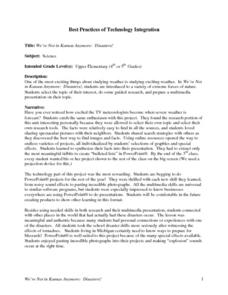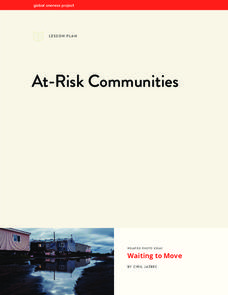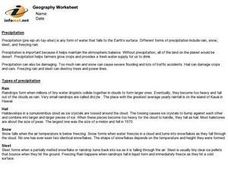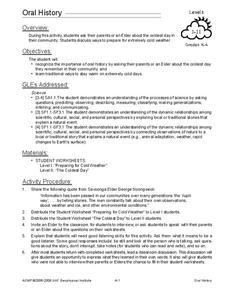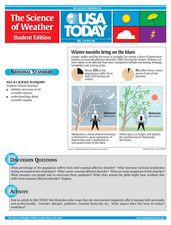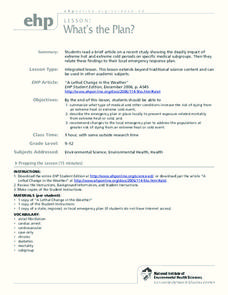Curated OER
The Big Blow
Students identify and explain factors that contribute to extreme storms in the Great Lakes. In this investigative instructional activity students study the weather systems in the Great Lakes and compare cyclones to tropical storms.
Curated OER
Our Savage Planet in the News
Students explore extreme earth phenomenons. In this savage planet instructional activity, students explore and report on various types of severe weather and earth phenomenons using the Internet, a word processor, or other multimedia device.
Curated OER
Weathering Landforms
Stduents create and color plaster landforms, and describe how weathering and erosion change the Earth's surface.
Curated OER
Weather Records
Students write newspaper articles based on weather records set around the world. Students read and discuss weather records and their results, then write a newspaper article about how the weather records have affected people around the...
Chicago Botanic Garden
Climate Change Around the World
It is unknown if cloud cover increases in response to carbon dioxide levels changing, helping climate change slow down, or if cloud cover decreases, allowing Earth to warm faster. Part four in the series of five lessons has classes...
Curated OER
Arctic Passage
Students plan a survival pack for severe Antarctic weather. They identify items necessary for survival in cold climates and which factors play a parat in keeping warm in the cold.
National Wildlife Federation
When It Rains It Pours More Drought and More Heavy Rainfall
Which is worse — drought or flooding? Neither is helpful to the environment, and both are increasing due to climate change. The 16th instructional activity in a series of 21 covers the average precipitation trends for two different...
Curated OER
Our Savage Planet in the News
Students research volcanoes, storms, atmospheric conditions and extreme environments. They collect information and create a simulation of a science newscast. They watch a video and write a letter as an eyewitness to an avalanche.
Curated OER
Canada's Arctic Barometer
Students research arctic climates. In this Web-quest investigation, students will identify Arctic climate changes, explain the effects of these changes, relate the changes to other regions, and write their findings in a letter format.
Curated OER
We're Not in Kansas Anymore: Disasters!
Students explore weather. They discuss a variety of extreme forces of nature. Students select a topic of their interest and research that topic. They prepare a multimedia presentation on their selected weather topic. Students present...
Global Oneness Project
At-Risk Communities
"Waiting to Move," a photo essay by Ciril Jazbec, brings into sharp focus the threats posed by climate change. Class members examine images of Shishmaref Island and the Native Alaskan Inupiate coastal villages that are impacted by rising...
Prince William Network
The Incredible Journey
Divide your school gym into breeding grounds and non-breeding grounds so that your zoologists can play a game simulating the seasonal migration of shorebirds. Players pick one of the included game cards and follow its directions, which...
Curated OER
Precipitation
Fourth graders identify the conditions that create rain. They read and discuss weather records, and write a news article that includes factual information fom one of the listed weather records.
Curated OER
Biomes: Extreme Climate
Students discuss the causes of global warming. In this earth science instructional activity, students examine how global warming is connected to the arctic and world climate. They write a paragraph about their interconnection.
Curated OER
Oral History
Students interview a Native Elder to learn about oral history and cold weather. In this weather lesson, students ask an Elder about the coldest day they remember in their community and complete two worksheets for the topic.
Curated OER
Picnic Possibilities
Fourth graders plan a picnic using weather data. Using accumulated weather data from various sources, they create a graph of the weather conditions in their region for a given period of time. Students interpret this data to predict the...
Curated OER
The Science of Weather
Students read an article. In this seasons instructional activity, students discuss the seasons and seasonal affective disorder. Students find an article that illustrates other ways that the environment negatively effects humans.
Curated OER
Extreme Heat
Students, in groups, investigage and demonstrate the science behind the development and characteristics of extreme heat.
Curated OER
The Science of Weather: Humidity makes air feel even hotter.
Students examine the effects of heat and humidity. In this weather lesson, students read a chart to determine the effects heat and humidity can have on the human body. This lesson includes an optional extension activity using a newspaper.
Curated OER
Vocabulary: Talking About the Weather-2
In this foreign language worksheet, students fill in the blanks for 10 weather related sentences. Each sentence has a list of three words to select from.
Curated OER
Vocabulary; Talking About the Weather-1
In this foreign language worksheet, students read 10 sentences related to the weather. They select the best response from those given to fill in the missing blank.
Curated OER
The Tibetan Plateau
Students discuss the characteristics of the biosphere, with a focus on the Tibetan Plateau. They participate in a question and answer period discussing biomes and climate patterns. They compare and contrast different ecosystems.
Curated OER
What's the Plan?
Is there a higher risk of dying on an intensely hot or incredibly cold day? Explore the effects of extreme weather on human health by reading a short article about a study done to address this question. Since the links in the lesson are...
Curated OER
It's Really Heating Up in Here!
Students create and observe a greenhouse effect model and discuss the implications of global warming theory for engineers, themselves and the Earth. They discover that Global warming is becoming an increasing concern as we learn more...











